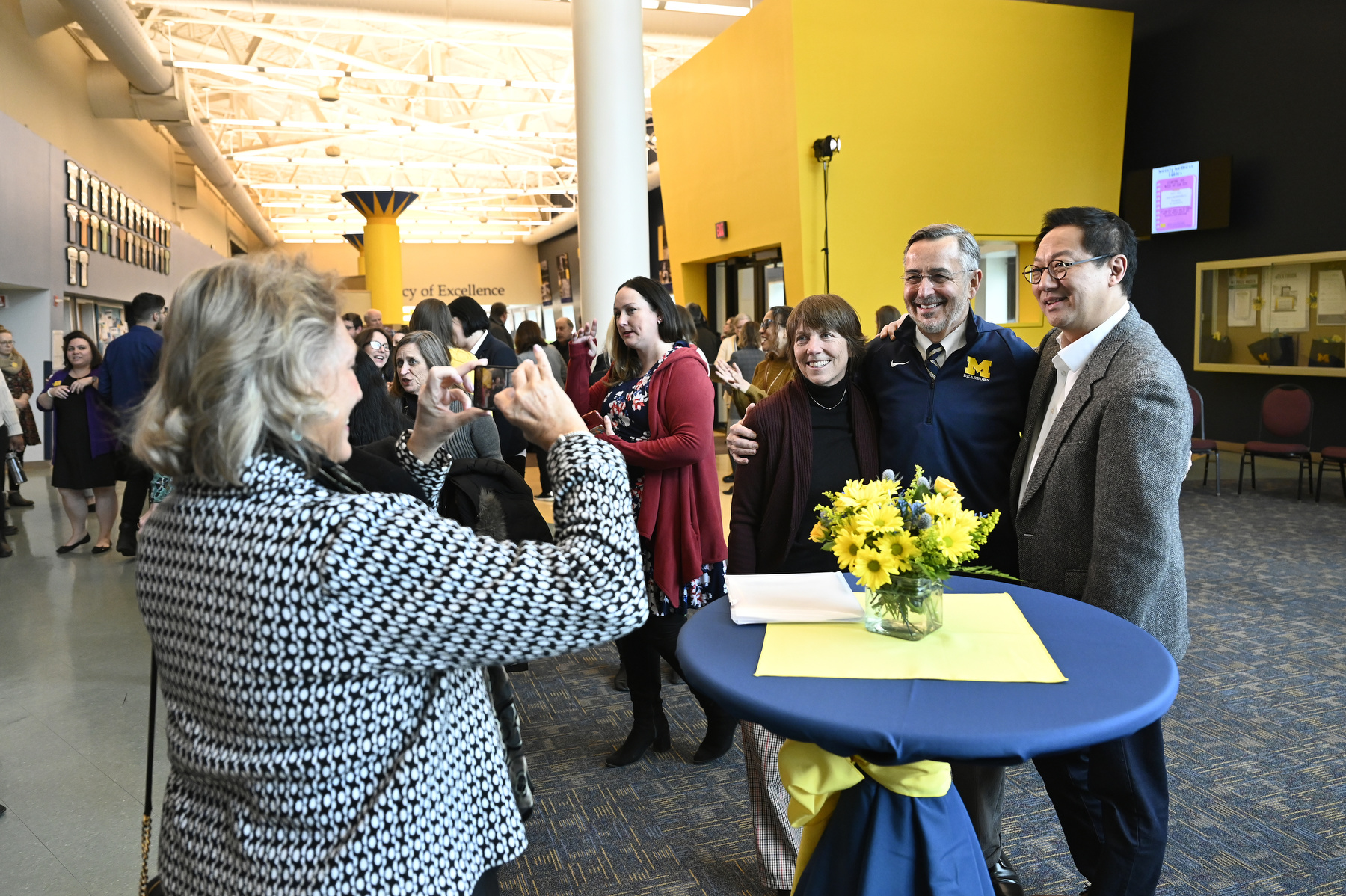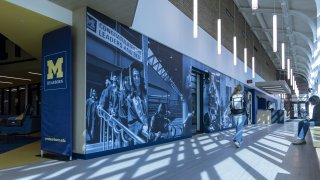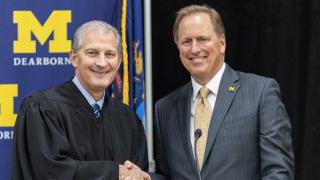Last Thursday, the U-M Board of Regents extended Chancellor Domenico Grasso’s term to another five years. U-M President Santa J. Ono celebrated Grasso’s reappointment with a UM-Dearborn campuswide celebration on Friday. To a standing room-only crowd, Ono said he’s confident UM-Dearborn will continue to thrive with Grasso’s strategic mind and caring heart. “Beyond the accomplishments, which are many, in your first term . . . what resonated with me is how you made people feel,” said Ono, remarking on his time with Chancellor Grasso and the conversations he’s heard from campus community members. “We’re inspired by you, by this campus and by your leadership, Chancellor Grasso.”
Among those accomplishments: Since 2018 UM-Dearborn research funding has grown exponentially, graduation rates increased and there are record-breaking international student enrollment numbers. In addition, UM-Dearborn reorganized its financial aid model to better support students with the most financial need, the campus' Engineering Lab Building opened and we’ve navigated a pandemic.
Looking ahead to the next five years, Grasso shared with Reporter what he’s learned, the challenges he anticipates and a Judy Garland quote he applies to the UM-Dearborn campus.
One of the lines that stood out from your recent State of the University address was this idea of building a “model 21st-century nonresidential campus.” Could you paint us a picture of what that means to you, and in particular, why the nonresidential part is something we could now view as an asset?
That’s a great question, and I’m still queried about it by different people who have different views of what a university should be like. Part of the answer boils down to numbers. We have enough qualified individuals in southeastern Michigan who live within commuting distance and may not need or want a residential experience to populate our campus to its capacity and have a vibrant experience here. At the same time, we’re seeing that we can easily reach beyond our borders with online education. In terms of substance, my thinking about the 21st-century nonresidential campus draws on what I’m seeing, for example, in California, where people are excited to go to work at a place like Google or Amazon or Apple. They go to work there, they don't live there. But those campuses are very visually attractive and provide nourishing and exciting experiences while people are there. So why can’t we do the same thing?
What’s key to making that work is having activities and opportunities on campus that go beyond just taking classes. Of course, the main attraction will always involve outstanding classroom or laboratory experiences with our terrific faculty, but we want to have experiences that enrich our students' lives in other ways. You’re already seeing some of that, whether it's enhancing our outdoor spaces with the new Adirondack chairs, lawn games or student lounges like the Wolverine Commons. I’ve even asked our folks to explore the idea of sleeping pods, so students could take a nap between classes if they needed to. The idea is students can still have a rich experience with us, but they don't have to stay here at night or on weekends, and can live at home to save money, or live in a city like Detroit or Ann Arbor, if that’s more of the experience they’re looking for.
So you’ve been here five years now. Put us in the time machine and talk about how you were approaching the job then, and some ways in which your views have shifted as a result of getting to know the community better.
When I came here, I had some appreciation for the Dearborn campus, but all of my experiences to that point were on residential campuses. I was at UConn, Smith College, the University of Vermont and then the University of Delaware. They all had beautiful residence halls, especially Smith. Smith had this house system where they had dining in each of the houses and seated meals on Thursday nights. It was almost like being at a country club. When I came here, I saw that as something Dearborn didn’t have. Like many of my predecessors and many of the faculty members and even some students, my thinking was that congregate living would be the next evolution of this campus. But I think this is where that famous quote by Judy Garland applies: “Always be a first rate version of yourself, not a second rate version of someone else.” Having been here through the pandemic, seeing the resilience of our students and how they’re successfully fitting this type of college experience into their otherwise full lives, I began to think, why not double down on this? You don’t have to emulate what others are doing to do something great. We can make it an even better experience for the students we serve and differentiate ourselves in ways that appeal to this generation of students.
The other thing I’ve really come to appreciate greatly is the difference that we make in our students' lives. Every president says that — and believes it — but the difference we make in our students' lives is truly remarkable. Because of the demographic groups we serve, when students come in, many seem timid about exploring the potential they have, or maybe even feel like they’re not worthy. By the time they leave, they’re self-confident, they have bright futures ahead of them, they’re changing their lives, the lives of their families, and then giving a hand up to others coming up behind them. That’s just so inspirational. I was somewhat familiar that this was the culture at Dearborn, but to be able to experience that on the day-to-day, that’s just the best feeling.

What are some areas you’d point to where we’re in a substantially different place now than five years ago?
Research is certainly one area. I think our faculty have enormous talent, but in the past, we weren’t always supporting them to the extent that they deserved. Now we are, and you’re seeing it pay off in a huge growth in research funding from external sources and in the impact their research is having. I think another area I see a significant shift is student success. We put a lot of new programs in place and our four-year graduation rate grew by 3%. I think we should be extremely proud of that, especially given the challenges universities and students faced over the past few years. Another thing I’m really proud of is the shift in our financial aid strategy to prioritize student need. Affordability is obviously a major factor in whether someone feels like a college experience is within reach, and frankly, I didn’t feel like we were using our financial aid resources most efficiently.
If we were doing this interview five years from now, what’s something you would hope you can add to the list of successes?
I’m hoping we can say that leveraging our 21st century non-residential experience and practice-based learning (PBL) model as differentiators is paying big dividends. I want to be able to say that we’re doing it in the classroom, we’re doing it in communities, and it’s ubiquitous across all disciplines. Our students will still be getting great classroom education, but it’s contextualized in real-world problems and on a beautiful, exciting and engaging campus. Industry and community partners are banging down our doors to be part of our practice-based programs and then hire our students. That’s what I see, and I think we can do it. I think PBL could really become a distinguishing identity of the university. A lot of schools do things like this and call it different things, like co-ops or applied work. Practice-based learning is sort of like that, but it’s a bit different because it’s not just about the experience off campus. Yes, we’ll still have internships and co-ops and other activities off campus. But during classroom time, we’re going to contextualize their work in engaging, collaborative and holistic practical problem solving, so it’s a continuum from the classroom to off-campus and then back to the classroom. This integrated approach is what will differentiate practice-based learning.
It feels like a bit of a tumultuous time for higher education. From your perch, what do you see as our biggest challenge over the next five years, and how can we cope with it?
Without a doubt, the biggest challenge will be the demographic downturn in southeastern Michigan. We’ll simply have fewer college-ready students graduating from high schools, and we, and our peer institutions, will still have the same number of faculty members and seats in our classrooms. We’ll now be competing more directly with each other, and we’ll either fill those seats or some will need to downsize. So we have to offer something that is going to be unique, or, if not unique, something that strongly differentiates us and is going to be worth coming here as opposed to going somewhere else. I think we’re still a terrific bargain, but we’re not that far away from the other public universities in this area in terms of cost. It’s a difference of only a few hundred dollars. So we have to offer something to students that they feel is worth it. Practice-based learning can be that. But of course the other thing that differentiates us is a Michigan degree. That block M is one of the most iconic symbols in all of higher education, in the U.S. and around the world. If you were going to give someone a passport for success, I think a University of Michigan degree would be high on that list of credentials.
###
Interview by Lou Blouin. Introduction by Sarah Tuxbury.





